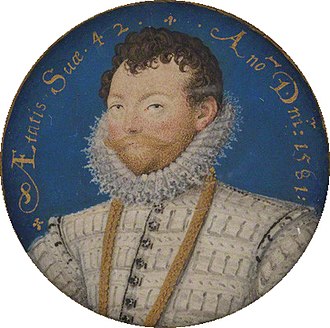Francis Drake

Vice Admiral Sir Francis Drake (1540 – 27 January 1596) was an English sea captain, privateer, navigator, slaver, and politician of the Elizabethan era.
Drake became a powerful enemy to the Spanish Empire.[1] He was the second sea captain ever to circumnavigate the world.[2] Encyclopedia Britannica calls him "the most renowned [famous] seaman of the Elizabethan Age."[3]
Life
Drake was born in Tavistock, England, and grew up in Kent.[3] There, he learned to be a sailor. Soon he was a shipmaster (captain).
Slavery
In early 1560s, Drake became a slave trader.[3]
According to an article by Ben Johnson:[4]
Drake and his second cousin, Richard Hawkins, led one of the first slavery trips to West Africa in 1567. It was illegal in English law to capture people and transport them, but in those days it was perceived as ok if they were already enslaved, non-Protestants or criminals! [Drake and Hawkins] were attacked by Spanish vessels and only two of the six British ships survived (those led by Drake and Hawkins themselves). This, as well as other factors, contributed to fueling the [hostility] between Spain and England, leading up to the war in 1585 and subsequent [Spanish] Armada.
By 1568, Drake commanded his own slave-trading ship, which he used to transport African slaves to the Spanish colonies in the Caribbean.[3]
Enemy of the Spanish Empire
From 1577 to 1580, Drake carried out the second circumnavigation of the world.[2] During this three-year voyage, he attacked towns and ships belonging to the Spanish Empire. He stole riches and treasure from these places and brought them back to England.[2] The year after he completed the voyage, Queen Elizabeth I knighted Drake on his ship, Golden Hind, in Deptford.
In 1588, Drake was second-in-command of the English Armada against the Spanish Armada.
Death & legacy
Drake died of dysentery in January 1596[5] after unsuccessfully attacking San Juan, Puerto Rico.
Drake's activities were legendary. He was a hero to the English but a pirate to the Spaniards.
Francis Drake Media
Sir John Hawkins (left) with Sir Francis Drake (centre) and Sir Thomas Cavendish
Jesus of Lübeck, flagship of Sir John Hawkins
A replica of the Golden Hind at Bankside in London
1829 portrait of Drake wearing the Drake Jewel
The Drake Jewel as painted by Marcus Gheeraerts the Younger in a 1591 portrait of Drake
Sir Francis Drake's new heraldic achievement, with motto: Sic Parvis Magna
Map of Drake's Great Expedition in 1585 by Giovanni Battista Boazio
References
- ↑ Rowse, A.L. (1955). The Expansion of Elizabethan England. Palgrave Macmillan. p. 241. ISBN 978-1403908131.
- ↑ 2.0 2.1 2.2 "The Famous Voyage: The Circumnavigation of the World 1577-1580 | Sir Francis Drake: A Pictorial Biography by Hans P. Kraus | Articles and Essays | Sir Francis Drake (Kraus Collection) | Digital Collections | Library of Congress". Library of Congress, Washington, D.C. 20540 USA. Retrieved 2025-04-07.
- ↑ 3.0 3.1 3.2 3.3 "Sir Francis Drake | Biography, Routes, Ship, Born, Death, Accomplishments, & Facts | Britannica". www.britannica.com. 2025-03-17. Retrieved 2025-04-07.
- ↑ "The Life of Sir Francis Drake". Historic UK. Retrieved 2025-04-07.
- ↑ According to the English calendar that was then in use, Drake's date of death was 27 January 1595, as the New Year began on 25 March.







